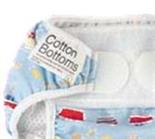
8 million disposable nappies are used in the UK every day.
This amounts to 1 million tonnes of waste annually. 90% of disposable nappies are sent to landfill, that’s over 2.5 billion nappies every year! With improved recycling methods elsewhere, nappies now contribute 8% of the household waste stream.
The alternative to disposable nappies is to use “Real Nappies”. The most common real nappy is a cotton or polyester wrap which can be fastened with Velcro, with a cotton pad insert. These can either be washed at home or your council will provide a laundering service.
It has been always assumed that reusable's were the most environmentally friendly option but, is it all as simple as that?
The first independent study into this area has researched the life cycle analysis of both systems e.g. the materials, chemicals and energy used in sourcing the materials (cotton or fluff pulp), transport, manufacture, packaging, disposal and in the case of reusable's - laundering.
For the three nappy systems studies (disposable, home laundered and commercially laundered) there was no significant difference between any of the environmental impacts—no overall system clearly has a better or worse environmental performance.
With disposables environmental performance can be improved by weight reduction and improvement in manufacturing, whereas with re-usable systems the user can achieve most environmental gain through reducing the energy consumed in washing and drying.
The wearing of nappies by children in the UK in one year results in the global warming and non renewable resource depletion impact equivalent to 0.5% of the impact from driving in the UK.
In conclusion, which nappy system parents choose to use should be judged on personal preference. Try looking at our other fact sheets for more ideas on how to reduce the environmental impact of our lifestyles.